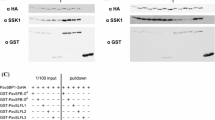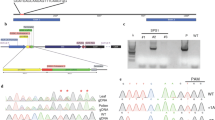Abstract
To investigate protein-protein interactions in gametophytic self-incompatibility, we used a yeast two-hybrid assay to identify proteins that could interact with the S-ribonuclease protein. These assays identified a pollen-expressed protein, which we have named PhSBP1, that appears to bind with a high degree of specificity to the Petunia hybrida S-ribonuclease. Although PhSBP1 activates reporter gene expression only when expressed in tandem with a S-RNAse bait protein, binding is not allele-specific. Sequence analysis demonstrated that PhSBP1 contained a C-terminal cysteine-rich region that includes a RING-HC domain. Because many RING-finger domain proteins appear to function as E3 ubiquitin ligases, our results suggest that ubiquitination and protein degradation may play a role in regulating self-incompatibility interactions. Together, these results suggest that PhSBP1 may be a candidate for the recently proposed general inhibitor (RI) of self-incompatibility ribonucleases.
Similar content being viewed by others
References
Adams, A., Gottschling, D.E., Kaiser, C.A. and Stearns T. 1997. Methods in Yeast Genetics. Cold Spring Harbor Laboratory Press, Plainview, NY.
Ai, Y., Singh, A., Coleman, C.E., Ioerger, T.R., Kheyr-Pour, A. and Kao, T.-H. 1990. Self-incompatibility in Petunia in-flata: isolation and characterization of cDNAs encoding three S-allele-associated proteins. Sex. Plant Reprod. 3: 130–138.
Ai, Y., Kron, E. and Kao, T.-H. 1991. S-alleles are retained and expressed in a self-compatible cultivar of Petunia hybrida. Mol. Gen. Genet. 230: 353–358.
Alché, J.D., Butowt, R., Castro, A.J. and Rodríguez-García, M.I. 2000. Ubiquitin and ubiquitin-conjugated proteins in the olive (Olea europaea L.) pollen. Sex. Plant Reprod. 12: 285–291.
Altschul, S.F., Madden, T.L., Schäffer, A.A., Zhang, J., Zhang, Z., Miller, W. and Lipman, D.J. 1997. Gapped BLAST and PSI-BLAST: a new generation of protein database search programs. Nucl. Acids Res. 25: 3389–3402.
Anderson, M.A., McFadden, G.I., Bernatsky, R., Atkinson, A., Orpin, T., Dedman, H., Tregear, G., Fernley, R. and Clarke, A.E. 1989. Sequence variability of three alleles of the self-incompatibility gene of Nicotiana alata. Plant Cell 1: 483–491.
Appel, R.D., Bairoch, A. and Hochstrasser, D.F. 1994. A new generation of information retrieval tools for biologists: the example of the ExPASy WWWserver. Trends Biochem. Sci. 19: 258–260.
Barlow, P.N., Luisi, B., Milner, A., Elliott, M. and Everett, R. 1994. Structure of the C3HC4 domain by 1H-nuclear magnetic resonance spectroscopy: a new structural class of zinc finger. J. Mol. Biol. 237: 201–211.
Bendixen, C., Gangloff, S. and Rothstein, R. 1994. A yeast mating-selection scheme for detection of protein-protein interactions. Nucl. Acids Res. 22: 1778–1779.
Beuken, E., Vink, C. and Bruggeman, C.A. 1998. One-step procedure for screening recombinant plasmids by size. Biotechniques 24: 748–750.
Borden, K.L.B. and Freemont, P.S. 1996. The RING finger domain: a recent example of a sequence-structure family. Curr. Opin. Struct. Biol. 6: 395–401.
Callis, J. and Bedinger, P. 1994. Developmentally regulated loss of ubiquitin and ubiquitinated proteins during pollen maturation in maize. Proc. Natl. Acad. Sci. USA 91: 6074–6077.
Chawla, B., Bernatzky, R., Liang, W. and Marcotrigiano, M. 1997. Breakdown of self-incompatibility in tetraploid Lycopersicon peruvianum: inheritance and expression of S-related proteins Theor. Appl. Genet. 95: 992–996.
Chien, C.-T., Bartel, P.L., Sternglanz, R. and Fields, S. 1991. The two-hybrid system: a method to identify and clone genes for proteins that interact with a protein of interest. Proc. Natl. Acad. Sci. USA 88: 9578–9582.
Clark, K.R. and Sims, T.L. 1994. The S-ribonuclease gene of Petunia hybrida is expressed in nonstylar tissue, including immature anthers. Plant Physiol. 106: 25–36.
Clark, K.R., Okuley, J.J., Collins, P.D. and Sims, T.L. 1990. Sequence variability and developmental expression of S-alleles in self-incompatible and pseudo-self-compatible petunia. Plant Cell 2: 815–826.
Clontech. 1998. Matchmaker Gal4 two-hybrid user manual (PT3061-1).
Dana, M.N. and Ascher, P.D. 1986. Sexually localized expressin of pseudo-self compatibility (PSC) in Petunia ×hybrida Hort. Theor. Appl. Genet. 71: 578–584.
Dean, A.D, and Greenwald, J.E. 1995. Use of filtered pipette tips to elute DNA from agarose gels. BioTechniques 18: 980.
de Nettancourt, D. 1977. Incompatibility in angiosperms. In: R. Frankel, G.A.E. Gall, M. Grossman and H.F. Linskens (Eds.) Monographs on Theoretical and Applied Genetics, Vol. 3, Springer-Verlag, Berlin.
Dodds, P.N., Bonig., I., Du., H., Rödin., J., Anderson., M.A., Newbigin, E. and Clarke, A.E. 1993. S-RNase gene of Nicotiana alata is expressed in developing pollen. Plant Cell 5: 1771–1782.
Doughty, J., Dixon, S., Hiscock, S.J., Willis, A.C., Parkin, I.A.P. and Dickinson, H.G. 1998. PCP-A1, a defensin-like Brassica pollen coat protein that binds the S locus glycoprotein, is the product of gametophytic gene expression. Plant Cell 10: 1333–1347.
Doughty, J., Wong, H.Y. and Dickinson, H.G. 2000. Cysteine-rich pollen coat proteins (PCPs) and their interactions with stigmatic S (incompatibility) and S-related proteins in Brassica: putative roles in SI and pollination. Ann. Bot. 85A: 161–169.
Fields, S. and Sternglanz, R. 1994. The two-hybrid system: an assay for protein-protein interactions. Trends Genet. 10: 286–292.
Flaschenreim, D.R. and Ascher, P.D. 1979. S allele discrimination in styles of Petunia hybrida bearing stylar-conditioned pseudo-self compatibility. Theor. Appl. Genet. 55: 23–28.
Freemont, P.S. 2000. Ubiquitination: RING for destruction? Curr. Biol. 10: R84–R87.
Garnier, J., Gibrat, J.-F. and Robson, B. 1996. GOR secondary structure prediction method version IV. Meth. Enzymol. 266: 540–553.
Golz, J.F., Su, V., Clarke, A.E. and Newbigin, E. 1999.A molecular description of mutations affecting the pollen component of the Nicotiana alata S-locus. Genetics 152: 1123–1135.
Golz, J.F., Clarke, A.E. and Newbigin, E. 2000. Mutational approaches to the study of self-incompatibility: revisiting the pollen-part mutants. Ann. Bot. 85A: 95–103.
Gu, T., Mazzurco, M., Sulaman, W. Matias, D.D. and Goring, D.R. 1998. Binding of an arm repeat protein to the kinase domain of the S-locus receptor kinase. Proc. Natl. Acad. Sci. USA 95: 382–387.
Hearn, M.J., Franklin, F.C.H. and Ride, J.P. 1996. Identification of a membrane glycoprotein in pollen of Papaver rhoeas which binds stigmatic self-incompatibility (S-) proteins. Plant J. 9: 467–475.
Huang, S., Lee, H.-S., Karunanandaa, B. and Kao, T.-H. 1994. Ribonuclease activity of Petunia inflata S proteins is essential for rejection of self-pollen. Plant Cell 6: 1021–1028.
Ioerger, T.R., Gohlke, J.R., Xu, B. and Kao, T.-H. 1991. Primary structural features of the self-incompatibility protein in Solanaceae. Sex. Plant Reprod. 4: 81–87.
Jackson, P.K., Eldridge, A.G., Freed, E., Furstenthal, L., Hsu, J.Y., Kaiser, B.K. and Reimann, J.D.R. 2000. The lore of the RINGs: substrate recognition and catalysis by ubiquitin ligases. Trends Cell Biol. 10: 429–439.
Joazeiro, C.A.P. and Weissmann, A.M. 2000. RING finger proteins: mediators of ubiquitin ligase activity. Cell102: 549–552.
James, P., Halladay, J. and Craig, E.A. 1996. Genomic libraries and a host strain designed for highly efficient two-hybrid selection in yeast. Genetics 144: 1425–1436.
James., P. 1997. PJ69-4A Update.
Jordan, N.D., Kakeda, K., Conner, A., Ride, J.P., Franklin-Tong, V.E. and Franklin, F.C.H. 1999. S-protein mutants indicate a functional role for SBP in the self-incompatibility reaction of Papaver rhoeas. Plant J. 20: 119–125.
Lecrenier, N., Foury, F. and Goffeau, A. 1998. Two-hybrid systematic screening of the yeast proteome. BioEssays 20: 1–6.
Lee, H.-S., Huang, S. and Kao, T.-H. 1994. S-proteins control rejection of incompatible pollen in Petunia inflata. Nature 367: 560–563.
Lewis, D. 1961. Chromosome fragments and mutation of the incompatibility gene. Nature 190: 990–991.
Lorick, K.L., Jensen, J.P., Fang, S., Ong, O.M., Hatakeyama, S. and Weissman, A.M. 1999 RING fingers mediate ubiquitin-conjugating enzyme (E2)-dependent ubiquitination. Proc. Natl. Acad. Sci. USA 96: 11364–11369.
Luu, D.-T., Qin, X., Morse, D. and Cappadocia, M. 2000. S-RNase uptake by compatible pollen tubes in gametophytic self-incompatibility. Nature 407: 649–651.
Matton, D.P., Maes, C., Laublin, G., Qin, X.K., Bertrand, C., Morse, D. and Cappadocia, M. 1997. Hypervariable domains of self-incompatibility RNases mediate allele-specific pollen recognition. Plant Cell 9: 1757–1766.
Matton, D.P., Luu, D.T., Xike, Q., Laublin, G., O'Brien, M., Maes, O., Morse, D. and Cappadocia, M. 1999. Production of an S-RNase with dual specificity suggests a novel hypothesis for the generation of new S alleles. Plant Cell 11: 2087–2097.
McAlister-Henn, L., Gibson, N. and Panisko, E. 1999. Applications of the yeast two-hybrid system. Methods 19: 330–337.
McLure, B., Mou, B., Canevascini, S. and Bernatzky, R. 1999.A small asparagine-rich protein required for S-allele-specific pollen rejection in Nicotiana. Proc. Natl. Acad. Sci. 96: 13548–13553.
McClure, B.A., Haring, V., Ebert, P.R., Anderson, M.A., Simp-son, R.J., Sakiyama, F. and Clarke A.E. 1989. Style self-incompatibility gene products of Nicotiana alata are ribonucleases. Nature 342: 955–957.
McClure, B.A., Gray, J.E., Anderson, M.A. and Clarke, A.E. 1990. Self-incompatibility in Nicotiana alata involves degradation of pollen rRNA. Nature 347: 757–760.
McCubbin, A.G., Chung, Y.Y. and Kao, T.-H. 1997. A mutant S 3 Rnase of Petunia inflata lacking RNase activity has a dominant-negative effect on self-incompatibility interactions. Plant Cell 9: 85–95.
Murfett, J., Atherton, T.L., Mou, B., Gasser, C.S. and McClure, B.A. 1994. S-RNase expressed in transgenic Nicotiana causes S-allele-specific pollen rejection. Nature 367: 563–566.
Pandey, K. 1967. Elements of the S-gene complex II. Mutations and complementation at the SI locus in Nicotiana alata. Heredity 22: 255–284.
Parry, S., Newbigin, E., Craik, D., Nakamura, K.T., Bacic, A. and Oxley, D. 1998. Structural analysis and molecular model of a self-incompatibility RNase from wild tomato. Plant Physiol. 116: 463–469.
Promega Corporation. 1999. Riboprobe® In Vitro Transcription Systems, Technical Manual 016.16
Rost, B. and Sander, C. 1993. Prediction of protein secondary structure at better than 70% accuracy. J. Mol. Biol. 232: 584–599.
Rost, B. and Sander, C. 1994. Combining evolutionary information and neural networks to predict protein secondary structure. Proteins 19: 55–77.
Royo, J., Kunz, C., Kowyama, Y., Anderson, M., Clarke, A.E. and Newbigin, E. 1994. Loss of a histidine residue at the active site of S-locus ribonuclease is associated with self-compatibility in Lycopersicon peruvianum. Proc. Natl. Acad. Sci. USA 91: 6511–6514.
Sambrook, J., Fritsch, E.F. and Maniatis, T. 1989. Molecular Cloning: A Laboratory Manual, 2nd ed. Cold Spring Harbor Laboratory Press, Plainview, NY.
Saurin, A.J., Borden, K.L.B., Boddy, M.N. and Freemont, P.S. 1996. Does this have a familiar RING? Trends Biochem. Sci. 21: 208–214.
Sims, T.L. 1993. Genetic regulation of self-incompatibility. CRC Crit. Rev. Plant Sci. 12: 129–167.
Sims, T.L. 1994. Molecular genetics of gametophytic self-incompatibility in Petunia hybrida. In: E.G. Williams, A.E. Clarke and R.B. Knox (Eds.) Genetic Control of Self-Incompatibility and Reproductive Development in Flowering Plants, Kluwer Academic Publishers, Dordrecht, Netherlands, pp. 19–41.
Schopfer, C.R., Nasrallah, M.E. and Nasrallah, J.B. 1999. The male determinant of self-incompatibility in Brassica. Science 286: 1697–1700.
Solovyev, V.V. and Salamov, A.A. 1994. Predicting á-helix and β-strand segments of globular proteins. CABIOS 10: 661–669.
Thompson, J.D., Higgins, D.G. and Gibson, T.J. 1994. CLUSTAL W: improving the sensitivity of progressive multiple sequence alignment through sequence weighting, position-specific gap penalties and weight matrix choice. Nucle. Acids Res. 22: 4673–4680.
Twell, D., Wing, R., Yamaguchi, J. and McCormick, S. 1989. Isolation and expression of an anther-specific gene from tomato. Mol. Gen. Genet. 217: 240–245.
Twell, D., Yamaguchi, J. and McCormick, S. 1990. Pollen-specific gene expression in transgenic plants: coordinate regulation of two different tomato gene promoters during microsporogenesis. Development 109: 705–713.
Twell, D., Yamaguchi, J., Wing, R.A., Ushiba, J. and McCormick, S. 1991. Promoter analysis of genes that are coordinately expressed during pollen development reveals pollen-specific enhancer sequences and shared regulatory elements. Genes Dev. 5: 496–507.
Tyers, M. and Jorgensen, P. 2000. Proteolysis and the cell cycle: with this RING I do thee destroy. Curr. Opin. Genet. Dev. 10: 54–64.
Author information
Authors and Affiliations
Rights and permissions
About this article
Cite this article
Sims, T.L., Ordanic, M. Identification of a S-ribonuclease-binding protein in Petunia hybrida . Plant Mol Biol 47, 771–783 (2001). https://doi.org/10.1023/A:1013639528858
Issue Date:
DOI: https://doi.org/10.1023/A:1013639528858




